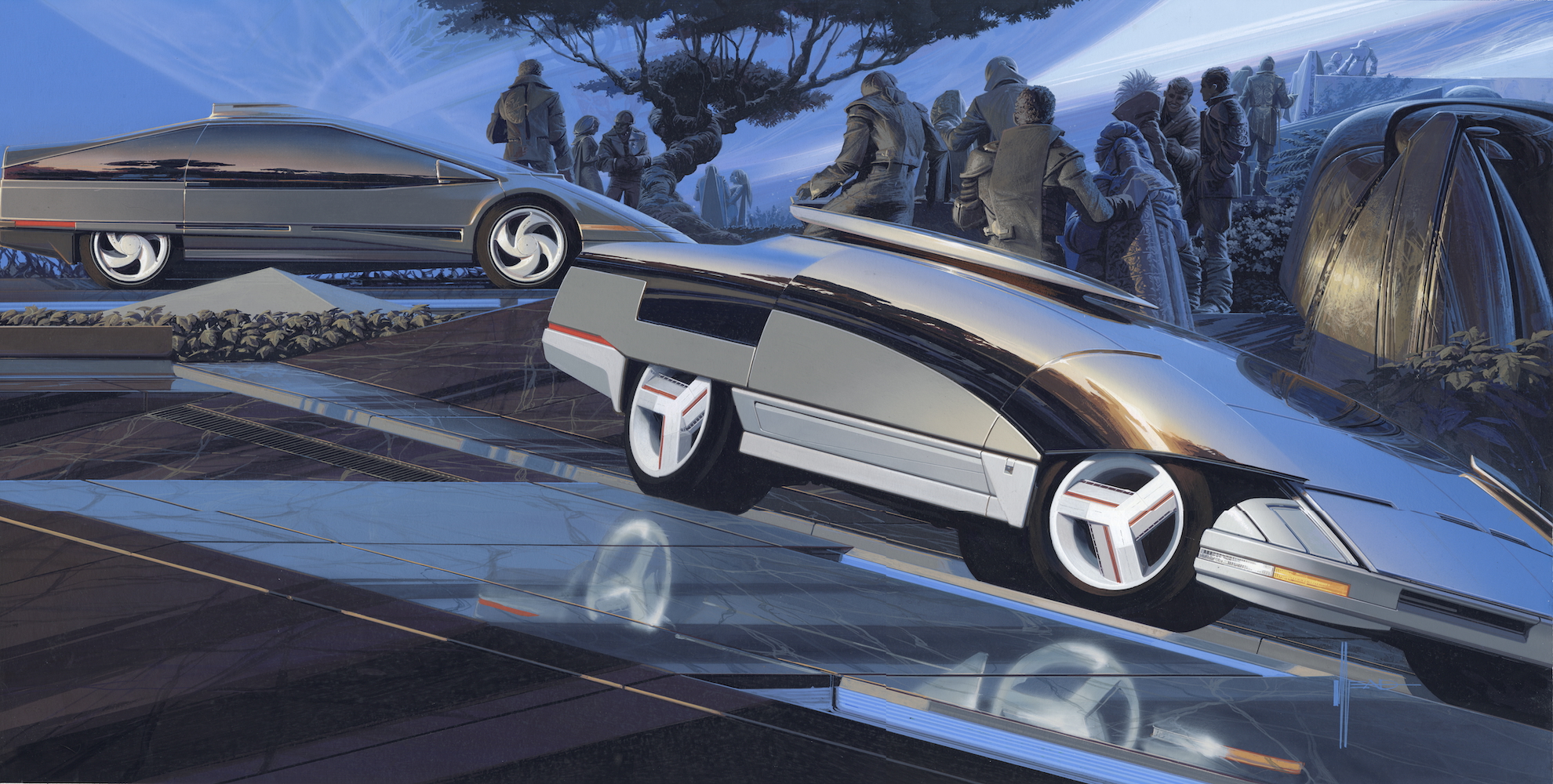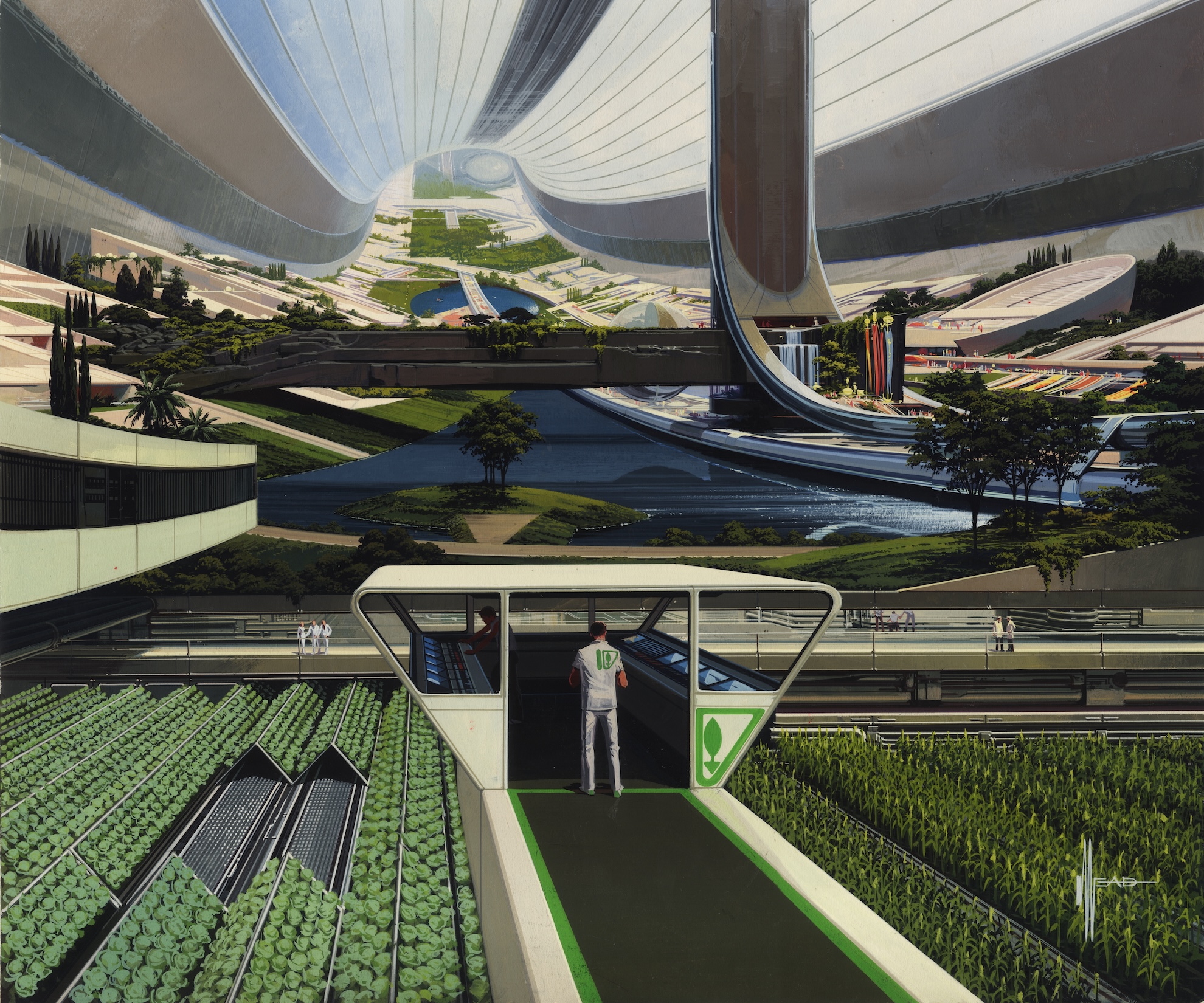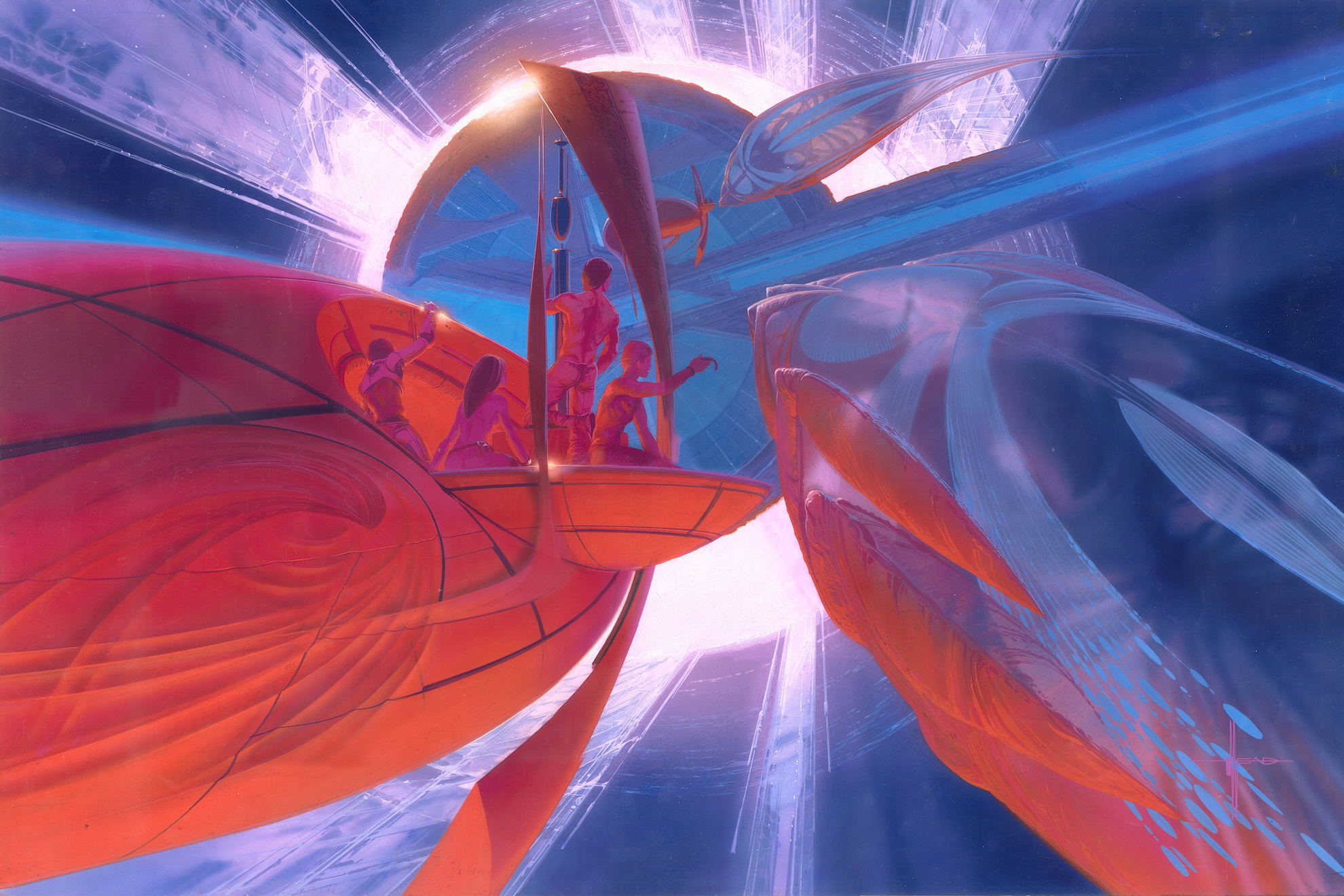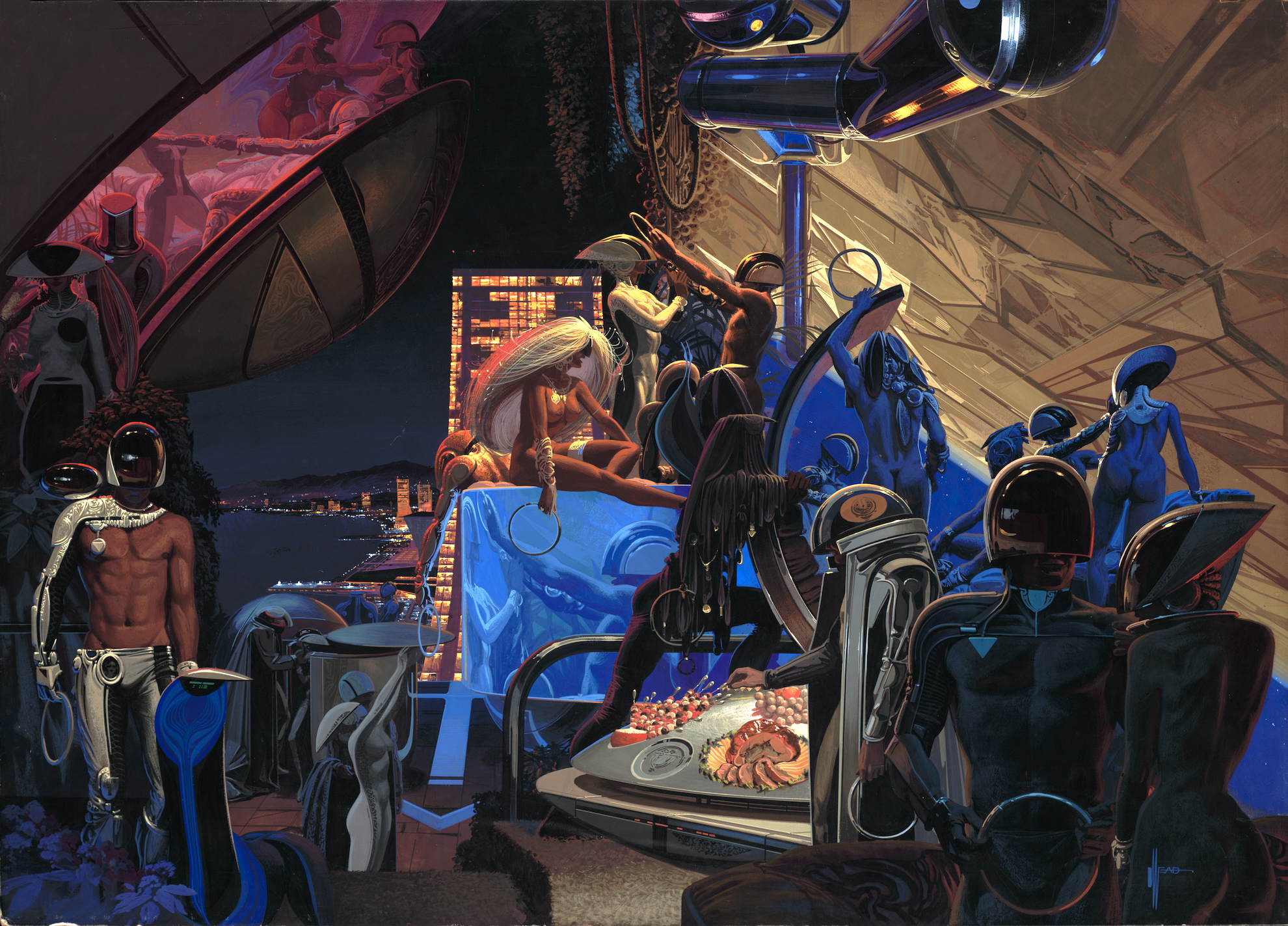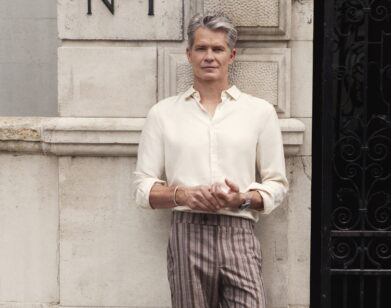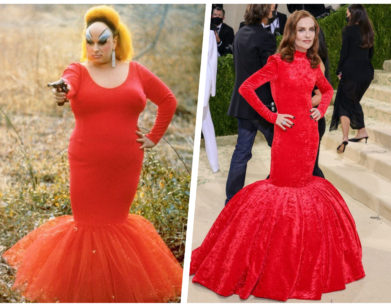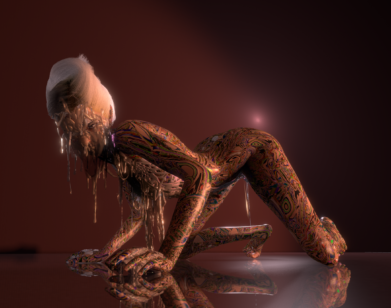RETROSPECTIVE
Grimes, Ridley Scott, and Others Tell Us How Designer Syd Mead Invented the Future
It may be hard to believe that a man born in St. Paul, Minnesota in the wreckage of the Great Depression shaped how we envision the future. Not the climate-doomer vision we have today, but something unprecedented: holistic, human, design-oriented, and even sexy. That man was the designer Syd Mead.
Mead was as quintessentially American an artist as one can be. He served in the U.S. Army and began his design career with industrial giants—U.S. Steel, Philips, and Ford—before going on to create conceptual and world designs for Hollywood, where he defined our collective sense of futurism. His work shaped Star Trek, Blade Runner, Aliens, and even influenced the look of Star Wars (George Lucas, in fact, is one of the few private owners of Mead’s artwork).
His approach always began with the practical, though he embraced the fantastical in equal measure, down to gelatinous charcuterie served on disc-like spaceships. Mead indulged art deco sensibilities while maintaining a sensual human presence. “There’s an overwhelming sense from Syd’s work that not only does the future look fabulous,” says the action movie director Drew Pearce. “he great news is that everybody fucks there too.”
In celebration of his legacy, Mead’s paintings are currently on exhibit for the first time in New York in the show Future Pastime, curated by Elon Solo and William Corman. Here, Mead’s chromatic, renaissance-esque canvases often recede to a hazy, distant vanishing point, giving the viewer the sense that there’s something to be discovered well beyond the horizon. Today, his aesthetic continues to influence our favorite futurists, from industrial designers like Marc Newson to musicians like Grimes and, of course, director Ridley Scott. To mark the new retrospective, we asked eight of the designer’s collaborators and admirers to reflect on Mead’s artistic vision and how it shaped their own.
———
RIDLEY SCOTT, FILMMAKER
“Syd Mead was enigmatic. He was also an engineer and a great future shock mind that he could visualize in a flash. As a designer, I had already collected Syd’s first book covering architecture to vehicles to electric kettles. Raymond Loewy on steroids! In that book, he had imagined visions of a future Hong Kong.
I had filmed in Hong Kong a few years before—when there were still 2000 ‘Junks’ in the harbor and no skyscrapers. Only dangerous high-rise slums and washing lines everywhere. From this visit, my vision for Blade Runner was born and indelibly etched in my mind. And with Syd’s future, my vision drew me to him immediately. [[Los Angeles]] would be populated by Chinese rather than today’s Spanish population.
The budget for a location shoot in Hong Kong was not feasible, so in a short time Syd and I walked the Warner Bros’ backlot and photographed all the sets that were still standing. Syd then drew on the existing buildings and the Retro architecture as the solution. RETRO was born. Syd’s imagination always began with practical evolutions and what was essential for change in urban environments.
The year before we met, he had spent time at Saab to design the future shape of the Saab car to the coming years. I asked, ‘What sells best, Syd?! The technical evolution or… ?’ Syd cut me off and said, ‘The bottom line, Rid. The look, always the look!’
He and I occasionally shared a very dry martini. He was a lot of fun and a visionary to boot.”
———
GRIMES, RECORDING ARTIST
“Syd Mead imagines dignity and grace into the future. My first encounter with his work was Blade Runner, an aesthetic that I’ve never been able to shake off. I like to think life imitates art, and if so, I’d appreciate more art deco grandiosity. Syd’s vision of America should be our goal.”
———
GARETH EDWARDS, FILMMAKER
“Any sci-fi filmmaker who isn’t inspired by Syd’s work is either blind, or a liar. All Sci-fi filmmakers are cursed with two choices: copy Syd, or not look as good. It’s like he saw the future, then came back to show us the way. We were lucky he lived in our world. And if we are really lucky, then one day we will live in his.
Whenever I need inspiration, you just look at one of Syd’s images and the floodgates open again. They are like keyholes peaking into an entire new world, just waiting for someone to smash the door down.”
———
MARCUS LEHTO, CO-CREATOR OF HALO
Though I didn’t know Syd worked on them at the time, Blade Runner, 2010, and Tron were hugely inspirational to me as a young adult. Aliens, of course, had a major impact on the Halo universe as we started developing the first in that game series.
Syd had a unique gift of blending functionality with such unique futuristic style which made his work stand out as something truly fresh and inspiring. His artistic vision served as a roadmap for me as I slowly developed my own style for games like Halo. His books, Oblagon and Sentury in particular, became dog-eared near my desk as I went to them frequently for inspiration and guidance.
One main takeaway from Syd’s work for me is that we can design things and spaces for the future that not only are functional and work intuitively, but are also infused with thoughtful and compelling styling which in turn allows us as humans to find joy and excitement when experiencing them.”
———
MARC NEWSON, INDUSTRIAL DESIGNER
“I can’t quite recall the first time I encountered Syd Mead’s work—such was the profound manner in which it infiltrated my very youthful subconscious. That was before I knew exactly who he was; suffice to say his work was without doubt the first futuristic imagery I was ever exposed to.
That work provided the language for how I and many others imagined the world might become, not only as fantasy but expressed through pragmatic industrial design. In many ways, he foretold that the future wasn’t going to be so ‘futuristic’; that today’s reality is in fact much more reassuringly mundane. His visions were of course optimistic but simultaneously believable…
His renderings are expressed in perfect analogue tones which today feel comfortably anachronistic but nonetheless elicit the same feelings and emotions I felt almost half a century ago—imagining something expansive, thrilling, and otherworldly. They are some of the most potent images, especially his seminal influence on Blade Runner. As an industrial designer essentially trying to predict the future, this sort of all-encompassing, holistic vision remains simply inspirational.”
———
DREW PEARCE, FILMMAKER
“Syd Mead is the archetypal artist that you’ve never heard of, but have always been aware of their work without knowing. And then, once someone joins the dots for you, you see both his creations and his influence literally everywhere. That’s why it’s so hard to pinpoint the first time I saw his art—I’m sure it was Blade Runner or Tron, but it’s there in everything I love: 50s positivism, 60s psychedelia, 70s glamour, 80s precision. It’s all there, together, seamlessly, gloriously.
The term ‘worldbuilding’ is horribly overused now, but Syd actually exemplified it. He literally couldn’t design a flying car without working out what utensils the passerby was using to eat their takeout dinner, or what the go-to architectural aesthetic of the entire city the car lived in might be. So many tiny, fascinating stories are hidden in every detail of his frames—and all of them are patently as thought-through and fully realized as the central idea itself. Syd’s hard-design background was clear and, of course, wildly impressive, but it’s that gesamtkunstwerk approach to entire civilizations, glimpsed only through the keyhole of a single product or moment, that’s truly awe-inspiring to me.
That said, I think what I find most inspirational about Syd’s approach is the positivity—and hotness—of his futurism. There’s an overwhelming sense from Syd’s work that not only does the future look fabulous—the great news is that everybody fucks there too. He does it without ever feeling like he’s trying to sell the sex (though perhaps his advertising work did encourage that side) or indulging in some tacky Barbarella-esque free-love fantasm. Instead, from Syd’s most utilitarian speculative fictions through to his most glamorous, these feel like worlds where everybody can still have a good time, can still live a little. Which, to me, is a subtly profound, and deeply human, ethos to infuse into our shared futures.”
———
ADAM SAVAGE, SPECIAL EFFECTS DESIGNER
“I was lucky enough to meet Syd and spend time in his house and office. I think he’s arguably the most important designer we’ve had in sci-fi, specifically, and futurism in general. Syd’s drawings had a physical weight to them. You understood impossible scope and scale from the barest of his lines. He gave us futures that were sometimes bleak, sometimes utopic, but always grounded in a physical reality that was uniquely transformative and thrilling.
From hand props to entire cities, Syd’s unique eye for possible futures was unparalleled. His was a deeply generous spirit. Syd’s drawings were the first designs I tried copying when I was a teenager just starting making models. His line was so physical, I felt like I could tell how much things weighed just from how Syd drew them. I would have loved to build one of his designs for a movie.”
———

Syd Mead, Moon 2000, 1979, Gouache on panel, 30 x 20 in / 76.2 x 50.8 cm
PATRIK SCHUMACHER, ARCHITECT
“As Principal of Zaha Hadid Architects, I wish to express my profound love, respect and admiration for Syd Mead—visionary industrial and set designer whose work transcended boundaries by letting creative imagination anticipate innovation. Mead’s futuristic visions shaped not only cinematic worlds but also influenced generations of architects and designers, myself included. His mastery in rendering speculative futures with precision, elegance, and conceptual depth inspires architects and designers to rethink form, function, and the aesthetics of progress. Syd Mead made the future feel both inevitable and desirable. His legacy endures as a beacon for all who seek to design tomorrow’s world. I honour his brilliance and spirit.”
———

